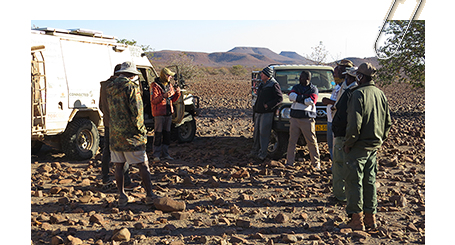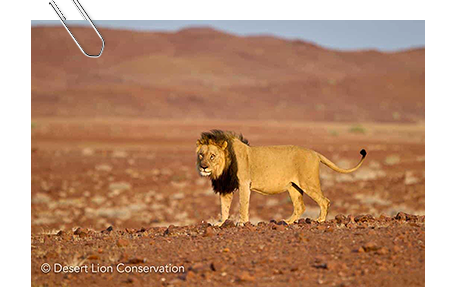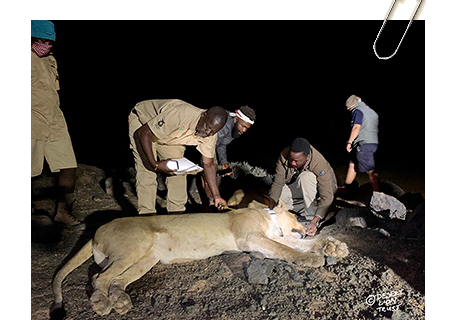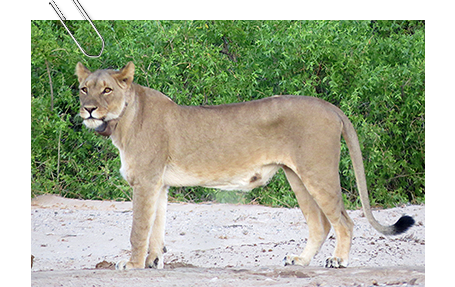Desert Lion conservation in Namibia’s communal conservancies
In Northwest Namibia, in the Namib Desert area west of Etosha National Park, is one of the few places where lion numbers have increased on communal land in the last 20 years. This local population is particularly unique to have adapted survival tactics in the inhospitable desert environments. Here, the number of desert lions has grown from a low of approximately 20 individuals in 1997 to an estimated 180 in 2015. By the late 1990s, regional lion range had contracted to approximately 7,000km2, these lions now range across more than 40,000km2.
This almost 400% population increase has primarily taken-place upon unfenced communal conservancy land; a unique community-based natural resource management (CBNRM) success story. Community-based conservation movement began with community leaders in the 1980s and Integrated Rural Development and Nature Conservation (IRDNC) as the supporting non-governmental organisation, implementing joint action to stop widespread commercial and subsistence poaching of wildlife. This unique approach to conservation placed ownership and subsequent protection of wildlife in the hands of cohabiting communities. However, the lion recovery success has been accompanied by human-lion conflict (HLC) as lion numbers increased, with the species currently listed as a vulnerable species under the IUCN Red List of Threatened Species.
In May 2019, the tenacious drought of over 8 years was declared a state of emergency in Namibia. The drought caused a dramatic decline in wildlife populations in the predisposed north-west Namibia, and both livestock farmers and wildlife are forced into areas they would not normally occupy, trailing what is left of depleting resources. As a result, human-wildlife conflict intensified further in conservancy areas in the region, including conflict with the desert. As in other part of rural Africa, lions targeted for retaliatory killings by communal farmers whose primary source of income is livestock farming is an important challenge facing the desert lion population in Northwest Namibia.
In 2017 IRDNC launched a specialised Rapid Response Team to address human-lion conflicts in northwest Namibia and implement mitigation measures. The field-based team primarily patrol the region for roaming predators and act as first-responders to reported incidents from concerned farmers. With the help of various conservation supporters, the Team constructed predator-proof kraals to keep livestock safe at night, translocated numerous lions away from farming areas to safer grounds, and trained Community Game Guards and Lion Rangers on lion response and management. The Team further installed Early Warning System towers with corresponding collars fitted on adult lions in hotspot areas, to keep track of problematic animals in the rugged and mostly inaccessible northwest landscapes, and warm farmers well in advance of any approaching predators.When lions have encroached into farming areas, the Rapid Response Team work with the community Lion Rangers to implement safe and tested non-invasive intervention techniques to move lions out of the area; including setting fires, playing loud music, using strobe and spotlights, and driving perimeter patrols with vehicles. These techniques have proven to scare lions away from livestock areas. Lions are then further monitored until they have left the area. These events are then recorded by Rapid Response Team leaders, the data captured in a central database and analysed to track responses and provide adaptive management options and protocols.
Other measures include spending time fostering positive relationships with farmers and community members towards lions and other predators, and the previous inimical community attitude is observed to shift in favour of sustainable human-lion conflict solutions. For example, local farmers who were extremely difficult and anti-lion were asked to join darting and lion translocation activities, in which they received the appropriate exposure to witness the preferred alternatives to killing lions
A recent project funded by the International Union for Conservation of Nature and European Union (EU) through the Save Our Species grant, will further support community-centred conservation of the desert-adapted lions of northwest Namibia, by further capacitating the Rapid Response Team and empowering locals to take leadership not just within their communities, but as valued members in the policy development process with government and other NGO stakeholders. Special effort is made through the project for community Lion Rangers to grow competency and confidence concerning human-lion conflict strategies, and knowledge concerning lion ecology, in order to increase management ownership of the unique desert-adapted lion at community level.
With the support of IUCN Save Our Species, co-funded by the European Union

- Mentoring of Lion Rangers and community members about lions in Anabeb Conservancy, Tina Vinjevold

- Male Lion in Obab River catchement, Desert Lion Conservation (DLC)

- Early Warning collars being replaced on two female lions in the Huab River, Desert Lion Conservation (DLC)

- Collared lioness in the Hoanib River, Tina Vinjevold




